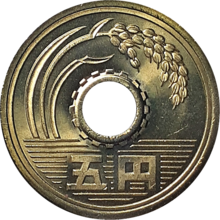
Back عملة 5 ين Arabic Koin 5 yen ID 五円硬貨 Japanese 5엔 동전 Korean ၅ ယန်းတန် ဒင်္ဂါး Burmese Moeda de cinco ienes Portuguese Femyen-mynt Swedish 5 yên (tiền kim khí) Vietnamese 五日圓硬幣 Chinese
Japan | |
| Value | 5 Japanese yen |
|---|---|
| Mass | 3.75 g |
| Diameter | 22 mm |
| Thickness | 1.5 mm |
| Center hole diameter | 5 mm |
| Composition | c. 65% Cu c. 35% Zn |
| Years of minting | 1870–present |
| Catalog number | KM 72, 72a, 96.1 and 96.2 |
| Obverse | |
 | |
| Design | Rice, water and gear |
| Design date | 1959 |
| Reverse | |
 | |
| Design | Tree sprouts |
| Design date | 1959 |
The 5-yen coin (五円硬貨, Go-en kōka) is a denomination of the Japanese yen. The current design was first minted in 1959, using Japanese characters known as the "new script" and kanji in the kaisho style, and were also minted from 1948 to 1958 using "old-script" Japanese characters in the gothic style.[1] Five-yen coins date to 1870 (when, due to the much higher value of the yen, they were minted in gold). The modern-day coin was first produced in 1948 with a differently styled inscription. This was changed in 1959 and the design has remained unchanged since.
The obverse of the coin depicts a rice plant growing out of the water, with "five yen" written in kanji; the reverse is stamped with "Japan" and the year of issue, also in kanji, separated by sprouts of a tree. The three graphic elements of the coin represent agriculture and fisheries, the key elements of the Japanese first-sector economy. Around the central hole, there is a gear that represents industry. It is the only Japanese coin in circulation to lack Arabic numerals on either side.
- ^ Coins from Japan: 5 Yen - Shōwa (Kaisho style) – 24-33 (1949-1958)" & "5 Yen - Shōwa (Gothic style) – 34-64 (1959-1989)"